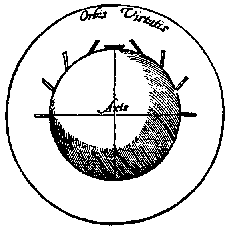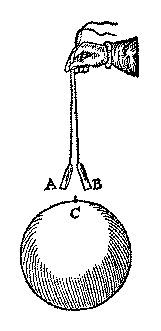The Terrella
|
Over the surface of the terrella he moved a magnetic compass. More accurately--since the compass had to stay horizontal--he moved the terrella, placing the compass next to various points on it. When the compass was level with the surface of the terrella, the needle always pointed to the magnetic north pole of the terrella. The picture here shows what happened when the compass was perpendicular to the terrella--the poles are on the left and right, the equator on top, and the needle in general slants down, just the way Robert Norman observed. At the poles, it points straight down, on the equator it is horizontal. This experiment convinced him that the directionality of the compass was caused by the Earth itself being a great magnet. Supposedly, he demonstrated his terrella to Queen Elizabeth--at least, a painting of such a demonstration exists. |
by David P. Stern
|
|
Geomagnetism since GilbertThe rest of the site contains a great deal of more recent developments--even about the Sun, on magnetism in space and on the magnetic fields of planets, some of them much stronger than the Earth's. You might enjoy, for instance, the section "About Electronic Magnetometers and about Smoking. " For and Earth Sciences class, some of the basic questions are:
Here only some ideas can be outlined, but you will find much more material on the web site, and many more stories. Why is the Earth magnetic? Gilbert thought magnetism was an inherent property of the Earth, permanent magnetism like that of lodestones.
But a few decades later it turned out that the direction of the compass needle slowly varied: a permanent magnet would not do so. Halley--the astronomer who predicted the return of the comet now named after him--came up with an ingenious explanation. The inside of the Earth contained spheres within spheres, each magnetized with its own poles, and the field changed because each sphere slowly rotated in relation to the others. We now know the Earth is too hot to be magnetic. As Gilbert discovered, magnetized iron lost its power when it was made red-hot-- although when it cooled again, it "captured" the surrounding magnetic field of the Earth, and became weakly magnetized in that direction. (Please remember that, we will come back to it! ) Although the core of the Earth is probably mostly iron, it is hot enough for that iron to be molten, far too hot for permanent magnetism.
In 1908 the astronomer George Ellery Hale--founder of the great observatories on Mt. Wilson and Palomar in California--analyzed the light of sunspots, and found evidence that they were all strongly magnetized. The Sun is even hotter than the Earth's core--it is gas, hot enough to conduct electricity. Whatever made sunspots magnetic could not be permanent magnetism. That only left electric currents, as Oersted had shown.
Go to Part 3
Back to the Master List |
Author and Curator: Dr. David P. Stern
Mail to Dr.Stern: earthmag("at" symbol)phy6.org
Last updated 25 November 2001
Re-formatted 9-27-2004



